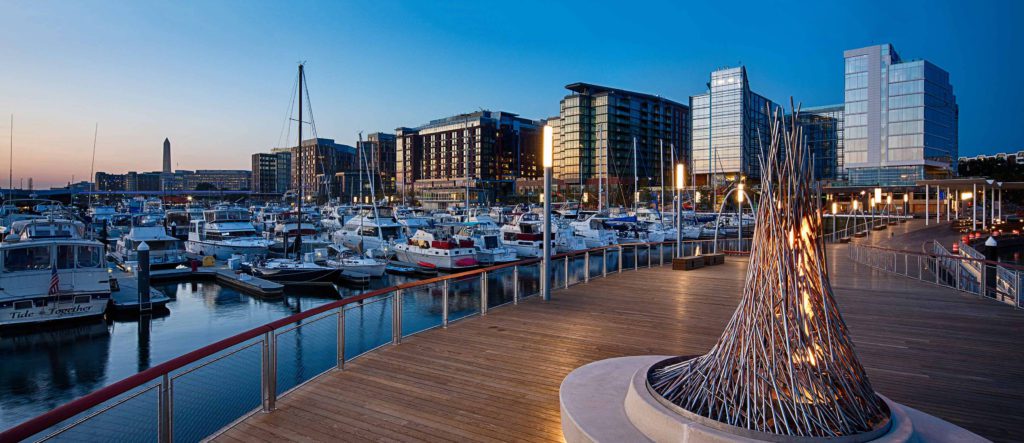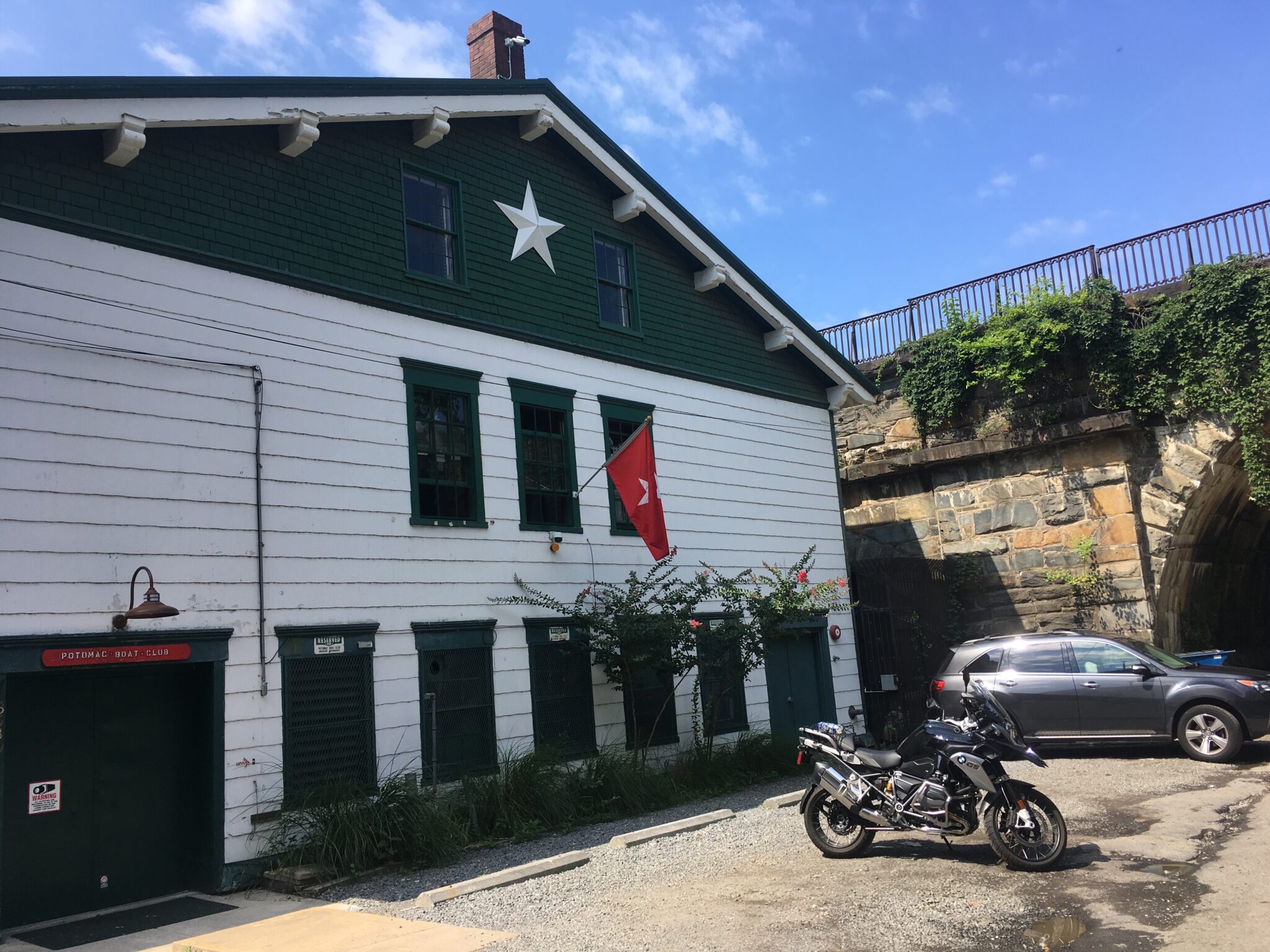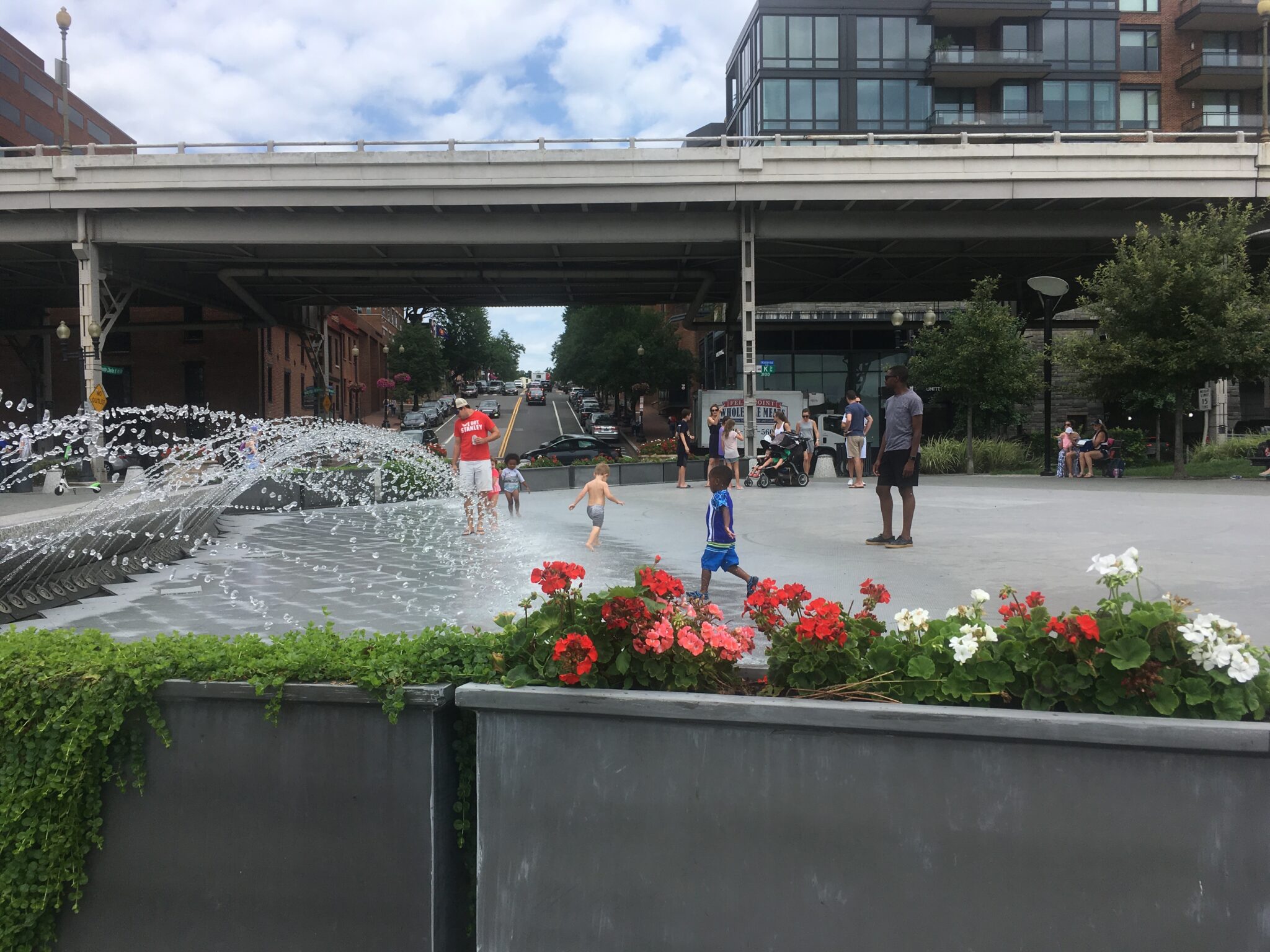Rollin’ on the River
By • August 8, 2018 0 1282

In the words of John Fogerty: “If you come down to the river, bet you gonna find some people who live.” Writing Creedence Clearwater Revival’s 1968 hit “Proud Mary,” Fogerty was inspired by a 1935 Will Rogers movie, “Steamboat Round the Bend.” Three years later, the song became a hit again in Ike & Tina Turner’s version, which starts out “nice and easy,” then explodes into a “nice and rough” second half, just like Tina said it would.
The 405-mile Potomac isn’t the 2,320-mile Mississippi, and Georgetown isn’t New Orleans or Memphis, but if you come down to our partly tidal river — which meets the Chesapeake Bay at Point Lookout, Maryland — you’ll find plenty of people who live, work and play there, especially in the summertime.
And to switch up the order on Tina, though the Georgetown waterfront was “nice and rough” for most of its history, these days it’s mostly “nice and easy.” Where once horses and mules labored, dogs play.
A port for tobacco, slaves, salt, molasses and, later, coal and flour — thanks to the Chesapeake & Ohio Canal and the B&O Railroad line known as the Georgetown Spur — for most of its history, Georgetown was all business where it met the water: dirty, seamy and industrial.
In 1949, after Francis Scott Key’s house, among others, was demolished to clear its path, the elevated Whitehurst Freeway opened, putting K/Water Street in shadow and adding air pollution and noise to an enclave already in decline.

Key Bridge Boathouse.
NEW RAPPORT WITH THE RIVER
The scene changed in a big way in 1986, with the replacement of a cement plant by the Washington Harbour complex of condominiums, shops and restaurants (and a fountain of dancing water) at 3000 and 3050 K St. NW, designed by Arthur Cotton Moore. When phase two was canceled, Sweden built its new, award-winning embassy on the site next to Rock Creek in 2006.
Georgetown Waterfront Park, completed in 2011 and now a national park, links Washington Harbour to Francis Scott Key Memorial Bridge with green space, plantings, walkways, river stairs, a labyrinth and a water feature. Senator Charles H. Percy Plaza, where Wisconsin Avenue terminates in the park, pays tribute to the Illinois senator who supported the group that became the nonprofit Friends of Georgetown Waterfront Park.
The last film in this summer’s Sunset Cinema series, “Footloose,” will be screened in Georgetown Waterfront Park on Tuesday, Aug. 14.
On summer weekends, when the weather is clear, the waterfront is packed with visitors and residents, including those who live in the repurposed mills and new condominium buildings that face the river. Since the incinerator at 31st and South Streets was transformed into condos and a 14-screen movie theater in 2002, the sole unavoidable reminder of the area’s industrial past is the former West Heating Plant on 29th Street. The toaster-shaped structure is to become the Levy Group’s Four Seasons Residences, designed by David Adjaye, with its onetime coal yard reborn as a Laurie Olin-planned public park linked to the C&O Canal and Rock Creek.
 TRAVELING ON THE RIVER
TRAVELING ON THE RIVER
At Washington Harbour, opposite Fabio and Maria Trabocchi’s Fiola Mare and the outdoor seating for Nick’s Riverside Grill and Tony and Joe’s Seafood Place, hourly sightseeing cruises are offered by Capitol River Cruises on the Nightingale, by National River Tours on the George Washington and by Boomerang Boat Tours on the Boomerang Pirate Ship. The Potomac Riverboat Company runs water taxis between Washington Harbour and the Wharf, Nationals Stadium, Old Town Alexandria, Virginia, and MGM National Harbor in Oxon Hill, Maryland.
Also out on the water, between Key Bridge and Arlington Memorial Bridge and beyond, are kayakers, canoeists and paddleboarders. As a National Park Service concessioner, Boating in DC operates Key Bridge Boathouse, Thompson Boat Center (east of Washington Harbour) and six others. Rental rates are $16 an hour for kayaks, $22 an hour for double kayaks and paddleboards and $25 an hour for canoes. Season passes are $229 for adults, $329 for families and $99 for seniors and students.
DOWN AT THE RIVER

The Potomac Boat Club.
As you head west along Georgetown Waterfront Park toward Key Bridge Boathouse, K Street turns to Water Street, the buildings get older and the natural setting becomes more … natural. Gypsy Sally’s, a link to Georgetown’s earlier honky-tonk and club scenes, and French café Malmaison occupy a white warehouse due to be demolished for a residential development.
On the river side, flying a red flag, is the green and white boathouse of the oldest rowing club in the D.C. area, the Potomac Boat Club, founded in 1869. Senior membership is limited to 300. Those looking to join are advised that “typical waiting periods can run up to two years.” The club runs the Charlie Butt Scullers’ Head of the Potomac Regatta. This year’s regatta, the 38th, will take place Sunday, Sept. 23.

Senator Charles H. Percy Plaza.
Farther west, behind a chain-link fence on National Park Service land, is the Washington Canoe Club’s compound. Lifelong club member and four-time Olympian Frank Havens died July 22 at age 93. The 200-member club is in the midst of an effort to restore its wooden boathouse, parts of which date to 1905.
At Key Bridge is the trail head for the Capital Crescent Trail, which runs along the Georgetown Spur freight rail line, discontinued in 1985. Hikers and bikers can also pick up the C&O Canal towpath here. The Park Service has several visitor centers along the 184.5-mile canal, which connects Georgetown (the mile-zero marker is just past Thompson Boat Center) with Cumberland, Maryland. Sections, including Locks 3 and 4, are currently being restored.

The Great Falls of the Potomac River.
CARING FOR THE RIVER — AND CANAL
The nonprofit Georgetown Heritage, a spinoff of the Georgetown Business Improvement District, is in the process of reimagining the portion of the canal within Georgetown and contracting for a new canal barge, pulled by two mules. In the 19th century, the complete trip took several days, with a shift change for the mules.
For those looking to support the canal’s restoration for recreational and educational purposes, the C&O Canal Trust will hold its eighth annual Park After Dark gala fundraiser on Saturday, Sept. 15, at Historic Great Falls Tavern in Potomac, Maryland.
The good news about the Potomac is that it’s getting cleaner. Beginning with efforts in the Johnson administration and the Clear Water Act, passed in the Nixon years, point-source pollution — discharges from factories, treatment plants and the like — has largely been eliminated. Though the river’s health got a D in 2011, its 2016 grade in Potomac Conservancy’s State of the Nation’s River report was B minus. In the most recent report, the river got a B.
Founded as a land trust, using conservation easements to protect healthy rural land upstream, Potomac Conservancy is focusing on urban runoff — “the real battle going forward,” according to Melissa Diemand, senior director of communications. The conservancy is also looking to make residents, particularly young professionals, “aware of their hometown river.” To that end, Potomac Conservancy is running a Paddle the Potomac “alternative happy hour” series at Key Bridge Boathouse. An Aug. 15 paddle is scheduled and another may be added in September due to demand. Cleanups are on the calendar at Jones Point Park on Sept. 15 and at Theodore Roosevelt Island on Sept. 22.
Finally, a save-the-date: on Thursday, Nov. 1, Robert F. Kennedy Jr., president of Waterkeeper Alliance, will be the keynote speaker at Potomac Riverkeeper Network’s fourth annual Law & Water Gala at the Hamilton, 600 14th St. NW. According to PRKN, Law & Water “honors those who protect and defend our Nation’s River and the watershed that provides clean drinking water to 6 million people.”

